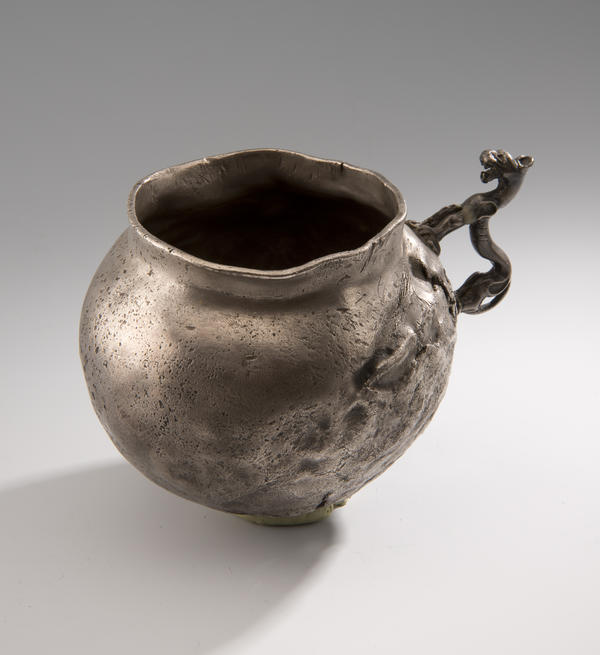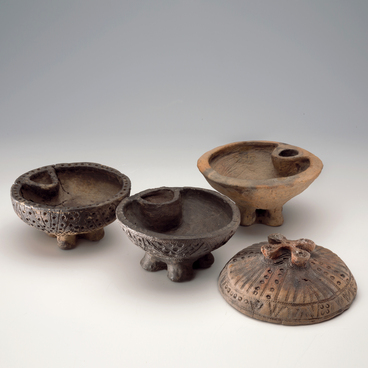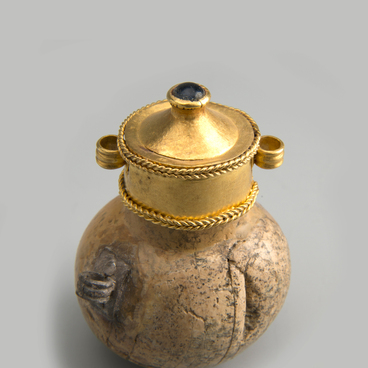The cup is part of a tableware set that archaeologists found in a mound in the Don and Kagalnik interfluve. The set made of precious materials was found during excavations in 1982 in mound 28 of the Vysochino-VII burial ground. Here, away from the grave, two hiding spots were made with funeral gifts hidden in them. Hill-diggers ravaged the burial site itself but never found the hiding spot. Archaeologists extracted a silver cup with a panther-shaped handle from one of them.
Сup with zoomorphic handle
Creation period
1st century A.D.
Dimensions
Height 9.7 cm. Diameter 8.5 cm.
Technique
silver, draw-forming, embossing, forging, soldering, raising, casting
Collection
Exhibition
6
Open in app#6
#4
The massive handle is made using the casting technique. The animal is shown standing on rectangular stands. The panther has big clawed paws, its teeth are bared. In ancient times the eyes, ears, shoulders and hips of the animal were decorated with leaf-shaped inserts of stone or glass characteristic of the Sarmatian animal style. To this day, only their collets have survived.
Fragment of the cup with zoomorphic handle
#8
The cup in combination with a golden bowl, a bronze pot, and a silver bowl, a jug and kantharoi — vessels for drinking wine — probably constituted a set of cult objects. All of these items could have been used during rituals: one of the forms of sacrifice to the gods without bloodshed was ceremonial drink-offering using pure wine.
Vessels of similar shape — with handles in the form of figures of predatory animals — were found throughout the territory occupied by Sarmatian tribes before. But they were made of wood. It was only in the rich burial sites of the nomads of the Lower Don region and the Volga region that similar cups of precious metals were known. Vessels of this type would be hung to the belt of a warrior. They were not just precious tableware, but a symbol of nobility.
The handles on Sarmatian cups were made in the shape of different animals: big cats, mooses, horses, hares. Most likely, these figures functioned as protection. Irina Zasetskaya, a late Sarmatian culture expert, considered the panther handle to be one of the most expressive among the finds of this type. Here is what she wrote about the panther: ‘…[The panther] is depicted with its teeth bared, expressing the state of rage of an attacking or defending animal, which is fully consistent with the idea of a guardian.’ The expert also noted that the diversity of motives could be explained by the fact that vessels with zoomorphic handles belonged to different families. And each had their own sacred animal considered the guardian and the patron of the family.
Vessels of similar shape — with handles in the form of figures of predatory animals — were found throughout the territory occupied by Sarmatian tribes before. But they were made of wood. It was only in the rich burial sites of the nomads of the Lower Don region and the Volga region that similar cups of precious metals were known. Vessels of this type would be hung to the belt of a warrior. They were not just precious tableware, but a symbol of nobility.
The handles on Sarmatian cups were made in the shape of different animals: big cats, mooses, horses, hares. Most likely, these figures functioned as protection. Irina Zasetskaya, a late Sarmatian culture expert, considered the panther handle to be one of the most expressive among the finds of this type. Here is what she wrote about the panther: ‘…[The panther] is depicted with its teeth bared, expressing the state of rage of an attacking or defending animal, which is fully consistent with the idea of a guardian.’ The expert also noted that the diversity of motives could be explained by the fact that vessels with zoomorphic handles belonged to different families. And each had their own sacred animal considered the guardian and the patron of the family.
#9
Ministry of Culture of the Russian Federation
read morehide
00:00
00:00
1x
Сup with zoomorphic handle
Creation period
1st century A.D.
Dimensions
Height 9.7 cm. Diameter 8.5 cm.
Technique
silver, draw-forming, embossing, forging, soldering, raising, casting
Collection
Exhibition
6
Open in app
Share




